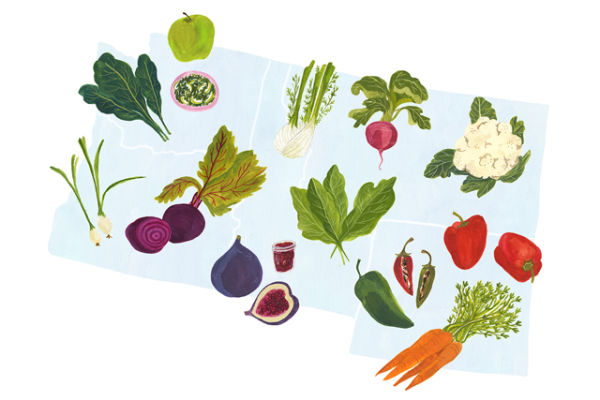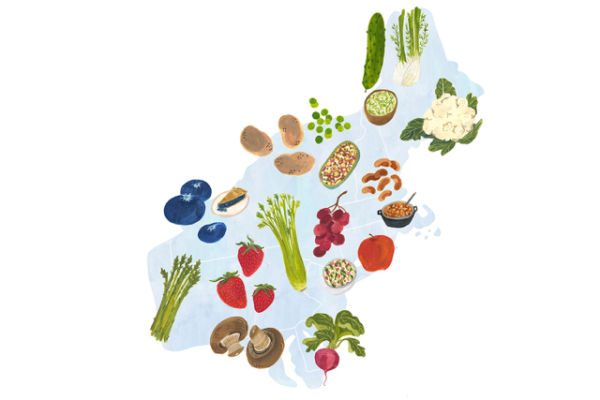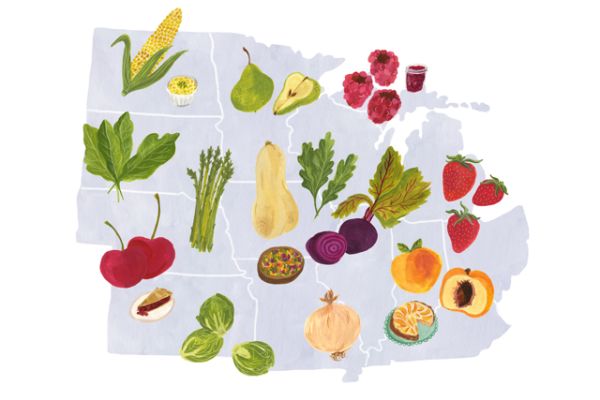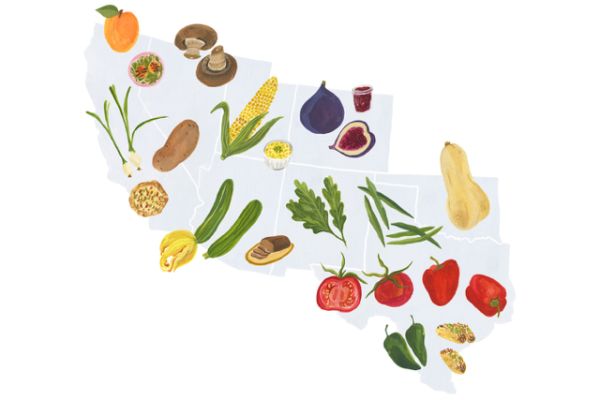Summer is the easiest time of year to eat seasonal produce! Ahead is a guide on what you’ll want to eat in your region.
So you’re ready to join the #LetsGetSeasonal campaign - you know seasonal foods are more delicious, better for you and the planet, better for your budget and better for your local economy. But what’s in season where you are? Read on for a growing guide for your region, and tips for finding the best seasonal produce.

NORTHWEST
In the Northwest, cold spring temperatures lead into short, cool summers with drizzly weather and cloudy skies. Farmers determine when to plant by monitoring soil and air temperatures. Most years, growers break ground in mid-March with an early planting of peas, the first harbinger of the season. Later in March through early April, farmers sow beets, scallions, cilantro, and carrots, then tender lettuces, spinach, broccoli, chives and fennel as the season progresses. Late spring sees cilantro, dill, and cauliflower going in the ground. Late summer crops of pole beans, summer squash, cucumbers, and corn are planted into June and harvested late August through early September.
Home gardeners rely on seeds started indoors or nursery-bought plants in the largest sizes available so that plants can be put in the ground further along in the spring season, while having time to ripen before the chilly, wet autumn weather sets in. The region contains lush soil, which plants love, but an excess of water brings the danger of rotting roots and fungal diseases. When rainfall is excessive, farmers use row cover to protect their crops.
During summertime at the market, keep your eyes open for apples, beans, beets, berries, broccoli, carrots, cauliflower, corn, cucumbers, lettuce, parsley, peas, pumpkins, radishes, spinach, Swiss chard, summer squash, and tomatoes.

NORTHEAST
The frigid winters of the Northeast can be just as hard on plants as they are on people. Repeat freezing and thawing in late fall and early spring can harm plants, so farmers often use cold frames to continue harvesting greens and lettuces while protecting immature plants before the last frost date. The true start to the growing season gets a later start here than the rest of the US, and the season is shorter overall. Growers rely on a longer harvest of cold-hearty crops like brassicas and root vegetables as well as storage crops like potatoes, onions, garlic, and apples. Farmers are especially aware of rain levels, frost dates, and pests, as all these can impact the short seasonal harvest. Winter is challenging, but spring - “mud season” - can be as well, with soggy, wet soil thawing and swelling from snow melt and spring rains.
The Northeast produces 26% of the of vegetables and 18% of the fruit that people in the region consume. Blueberries are a special summer treat in the Northeast, but be sure to enjoy apples later in the season, as well as grapes, cucumbers, cauliflower, and potatoes. Look for growers producing sprouts and mushrooms that can round out a local diet in winter months.

MIDWEST
The Midwest is all about extremes - summers are hot and humid, while frigid winters bring lots of snow. Spring is short and fall is cool, leaving a relatively brief window for planting and harvesting from roughly April to October. Home gardeners and farmers in Michigan, North Dakota, Minnesota, and Wisconsin have an even shorter growing season.
While hard frost and hot summers characterize the area, the Midwest has some of the most fertile soil in the US from glacial deposits over two million years ago. The region’s grain fields are legendary, but this summer, look for sweet corn, raspberries, greens, beets, and the famous Michigan cherries among other crops. In the cold season, home growers and large-scale farmers can grow lettuces by giving them protection with a frost cover, and some careful gardeners can also produce peas, radishes, spinach, carrots, turnips, arugula, parsley, and dill.

SOUTHEAST
As you go further south in this region, the climate can be warm enough to be almost a mirror image of the rest of the country. During the height of the hot summer months, the fields will produce little more than cowpeas, okra, and eggplant, but greens, root vegetables, lettuces, and frost-friendly cruciferous vegetables (think cabbage, kale, broccoli, and cauliflower) are abundant during the mild winter months. The longest growing season in this region is in central and south Florida, where many tropical fruits can grow throughout the year. Year-round, expect to see okra, potatoes, greens, and pecans, which are harvested in November, but can keep for the year if properly stored. In the early summer, look for juicy tomatoes, berries, onions, peaches, squash, and sweet potatoes - get ready to can and store the harvest during the less-productive hot, summer months!

SOUTHWEST
The Southwest’s year-round growing season is split in two by a brief hot, dry season. Farmers plant fast-growing, cool-season crops for spring, heat-tolerant vegetables for summer, and fine edibles for fall. Frost dates across the large region vary. In the west and western prairie states, the heavy growing season is roughly from early June to August, while in the north and interior areas the growing season is longer - from early May to September. In the desert areas of Arizona, New Mexico, West Texas, Oklahoma, and southwest Kansas the growing season is even longer, from April to early November, with chilly temperatures from November to February.
More than one-third of vegetables and two-thirds of our fruits and nuts in the United States are grown in California. During times of drought, farmers must rely solely on irrigation, raising concerns about water usage and sustainability, so look to small growers and ask questions about their farming methods. At the market, look for native crops, or produce suited for the often arid conditions of the region: avocados and grapes in California, sustainably grown lettuces and greens in Arizona, chile peppers and beans in New Mexico, peanuts in Oklahoma, and pecans in Texas.
#LETSGETSEASONAL
Ready? Put these tips to work to make seasonal eating part of your summer plans!
Get Technical
Put your iPad or laptop to work to help you locate local farms, farm stands, and farmers’ markets in your area. Sites like localharvest.org, eatwellguide.org, and eatlocalgrown.com are a great resource to connect with what’s growing near you.
Join Up!
Consider joining a CSA (Community Supported Agriculture) program through a local farm. You’ll pay for a season’s worth of produce up front, allowing farmers to pay for seeds, supplies, and labor. In exchange, you’ll get a bountiful box of produce each week.
Shop Co-Op
If your community has a co-op grocery, this can be a great place to find local and seasonal produce since many are committed to local farmers and strengthening the local economy. Be sure to ask what’s local if signage doesn’t indicate.
Extend It
When it comes to extending the season, your freezer is your friend. Prepare seasonal foods at the peak of ripeness and store in freezer bags for enjoying later in the season. Canning, pickling, drying, and preserving are options too - here’s a primer for beginners.
Grow It!
The best option for local, affordable food is right outside your back door. Even a small herb garden can add seasonal flavor to your cooking, and once you start, you might find yourself making room for tomatoes, greens, a fruit tree . . .
Looking for another way to get seasonal this summer? Shop our fun t-shirt collection for a delightful guide, and rep your region with pride!


